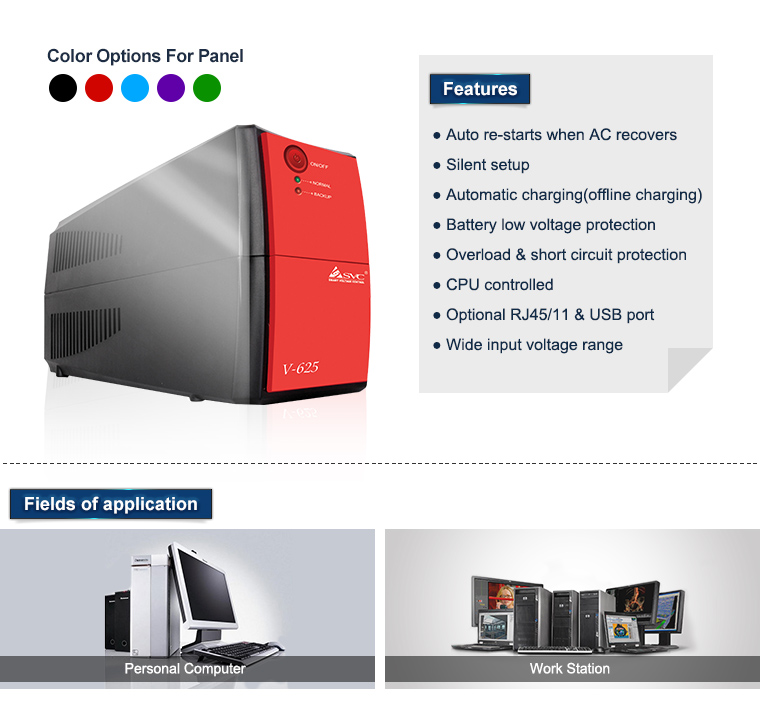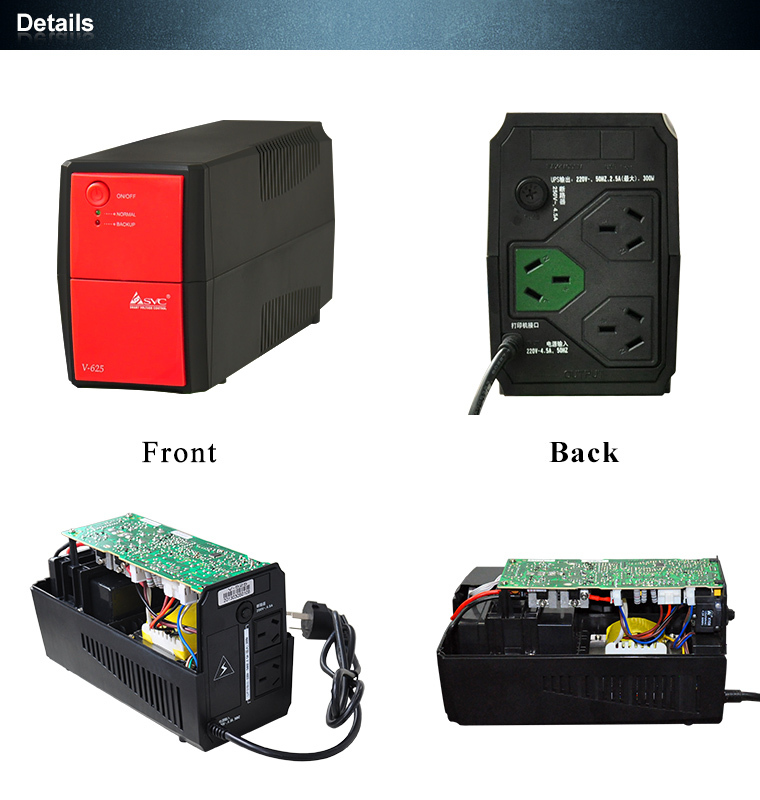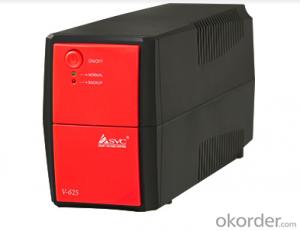UPS Uninterrupted Power /12V Portable Electrical DC To AC UPS Uninterrupted Power Supply
- Loading Port:
- China main port
- Payment Terms:
- TT OR LC
- Min Order Qty:
- 20 carton
- Supply Capability:
- 10000 carton/month
OKorder Service Pledge
Quality Product, Order Online Tracking, Timely Delivery
OKorder Financial Service
Credit Rating, Credit Services, Credit Purchasing
You Might Also Like
12V Portable Electrical DC To AC UPS Uninterrupted Power Supply


| Model | V-525 | V-625 |
| Capacity | 500va/300w | 600va/360w |
| INPUT | ||
| Input voltage | 110/120VAC or 220/230/240VAC | |
| Input voltage range | 90~132VAC / 175~265VAC | 85~150VAC / 145~290VAC |
| Frequency range | 60/50HZ/(Auto sensing) | |
| OUTPUT | ||
| Output voltage | 110/120VAC or 220/230/240VAC | |
| Output voltage range | 90~132VAC / 175~265VAC | 102~132VAC /200~255VAC |
| Output frequency | 60±0.5Hz or 50±0.5Hz(Batt. Mode) | |
| Output wave form | PWM(Batt. Mode) | |
| Transfer time | Typical 2-6ms, 10ms MAX / 2-6ms, 10ms | |
| BATTERY | ||
| QTY.&capacity of battery | 12V/4AH×1pc | 12V/7AH×1pc |
| Charging period | 4-6 hours recover to 90% capacity | |
| PROTECTION | ||
| Full protection | low voltage & overload & short circuit protection | |
| PHYSITAL | ||
| (kg) / Net weight (kg) | 4.5 | 5 |
| (mm) / Unit dimention (mm) | 255*98*140 | 300*95*140 |
| ENVIRONMENT | ||
| Environment of performance | Temperature 0°C~40°C, Humidity 20%~90% | |
| Noise level | Less than 40 dB | |
| MANAGEMENT | ||
| LCD or LED, RJ45/11 & USB | Optional | |

Feature:
Auto re-starts when AC recovers
Slience setup
Battery low voltage protection
Overload & short circuit protection
CPU control
Optional RJ45/11 & USB port
Wide input voltage range
Field of application
PC, Work stating
Small communication equipment

- Q:Can solar energy systems be used in areas with limited access to transportation?
- Yes, solar energy systems can be used in areas with limited access to transportation. Solar energy systems are typically self-contained and require minimal maintenance, making them suitable for remote or isolated locations. Additionally, advancements in battery storage technology allow solar energy to be stored and used during times when sunlight is not available, further enhancing its suitability for areas with limited transportation access.
- Q:Can solar energy systems be used for powering electric train systems?
- Yes, solar energy systems can be used to power electric train systems. Solar energy can be converted into electricity using photovoltaic (PV) panels or concentrated solar power (CSP) systems. This electricity can then be used to power the traction motors of electric trains, eliminating the need for traditional fossil fuel-powered engines. The feasibility of using solar energy for train systems depends on various factors such as the availability of sunlight, the size and efficiency of the solar panels, and the energy requirements of the trains. For example, in regions with abundant sunlight, such as deserts, solar energy can be harnessed effectively to power train systems. There are already several successful examples of solar-powered train systems around the world. For instance, the Byron Bay Train in Australia is powered entirely by a solar train system, relying on a combination of solar panels and battery storage. In addition, a section of the railway line in India is powered by solar energy, providing clean and sustainable transportation. Implementing solar energy systems for powering electric trains can bring numerous benefits. First and foremost, it reduces the dependence on fossil fuels, decreasing greenhouse gas emissions and contributing to combating climate change. Solar energy is a renewable source, so it offers a sustainable and long-term solution for powering train systems. Moreover, solar-powered trains can help reduce operating costs as they require less maintenance and are not subject to fluctuating fuel prices. However, there are also some challenges associated with using solar energy for train systems. The initial installation cost of solar panels and related infrastructure can be high, although the long-term operational savings can outweigh this investment. Additionally, the intermittent nature of sunlight can pose a challenge, especially during cloudy or nighttime conditions. This can be addressed by utilizing battery storage systems, which store excess energy generated during peak sunlight hours and release it when needed. In conclusion, solar energy systems can indeed be used for powering electric train systems. With advancements in solar technology and the increasing need for sustainable transportation, solar-powered trains have the potential to play a significant role in the future of rail transportation, promoting clean energy and reducing environmental impacts.
- Q:Do solar energy systems require planning permission?
- Yes, solar energy systems typically require planning permission in most regions. The exact regulations and requirements may vary depending on the location and the specific characteristics of the system. It is advisable to consult with local authorities or a professional installer to ensure compliance with the relevant planning regulations and obtain proper permission before installing a solar energy system.
- Q:Can solar energy systems be used in countries with low sunlight availability?
- Solar energy systems can still be employed in countries with limited sunlight. Although these systems depend on sunlight to produce electricity, technological advancements now enable the efficient capture and utilization of even small amounts of sunlight. Moreover, solar energy systems can be engineered to integrate other renewable energy sources like wind or hydroelectric power to compensate for the scarcity of sunlight. Furthermore, energy storage systems like batteries can store surplus energy during periods of low sunlight and release it as required. Consequently, solar energy systems remain a feasible and sustainable choice for electricity generation even in countries with insufficient sunlight.
- Q:Can a solar energy system be installed on a community center or clubhouse?
- Yes, a solar energy system can be installed on a community center or clubhouse. In fact, community centers and clubhouses are ideal locations for solar installations as they often have large rooftops or open spaces that receive ample sunlight. Installing solar panels on these buildings can help reduce energy costs, provide a sustainable power source, and contribute to the community's environmental efforts.
- Q:Can solar energy systems be used for powering outdoor recreational activities?
- Yes, solar energy systems can definitely be used for powering outdoor recreational activities. Solar panels can be installed in various outdoor locations, such as campsites, parks, or sports fields, to generate clean and renewable energy. This energy can be used to power outdoor lighting, charging stations for phones and other devices, music systems, or even small appliances like refrigerators or grills. Solar energy systems are environmentally friendly, require minimal maintenance, and can provide a reliable and sustainable power source for a wide range of outdoor recreational activities.
- Q:What is the difference between a solar energy system and a solar thermal system?
- A solar energy system refers to a broader term that encompasses both solar thermal systems and photovoltaic systems. Solar thermal systems specifically focus on converting sunlight into heat energy, which is then used for heating water or space. On the other hand, photovoltaic systems convert sunlight directly into electricity using solar panels.
- Q:What are the different mounting options for solar panels?
- The different mounting options for solar panels include roof-mounted, ground-mounted, pole-mounted, and tracking systems. Roof-mounted systems are the most common and are installed on the roof of a building. Ground-mounted systems are installed on the ground using a fixed structure or a tracking system. Pole-mounted systems are mounted on poles and can be adjusted for optimal sun exposure. Tracking systems allow solar panels to move and follow the sun's path throughout the day, maximizing energy production.
- Q:Can solar energy systems be used in areas with limited grid infrastructure?
- Solar energy systems are indeed suitable for use in areas that have limited grid infrastructure. In fact, one of the key benefits of solar energy is its ability to supply electricity in remote and off-grid locations. By converting sunlight into energy, solar panels generate electricity without relying on a connection to the traditional power grid. This makes solar energy systems an ideal choice for remote areas like rural communities or developing regions, where it may not be financially or technically feasible to extend the grid infrastructure. Through the installation of solar panels and the use of energy storage systems like batteries, these areas can generate and store their own electricity, even when sunlight is scarce or during nighttime. This not only grants access to reliable and clean energy, but also fosters energy independence and resilience in regions with limited grid infrastructure. Moreover, solar energy systems can be easily adjusted in scale to meet the energy demands of the community, making them a versatile and sustainable solution for powering areas with limited grid infrastructure.
- Q:What is the impact of electromagnetic interference on the performance of solar panels?
- Solar panels can be significantly affected by electromagnetic interference (EMI). EMI refers to the disturbance caused by electromagnetic radiation from various sources like power lines, electronic devices, or radio waves. This interference can disrupt the normal functioning of solar panels and decrease their efficiency. The primary effect of EMI on solar panels is the degradation of the photovoltaic cells' ability to convert sunlight into electricity. When exposed to electromagnetic radiation, the cells can become less efficient in converting sunlight, resulting in less power generated. This directly impacts the overall output of a solar panel system and its ability to effectively meet energy demands. Furthermore, EMI can introduce electrical noise into the system, interfering with the required voltage and current levels needed for proper operation. This noise disrupts the control circuits and electronics within the solar panel system, leading to inaccurate measurements and potential malfunctions. In severe cases, excessive EMI can even damage the electronic components of the solar panel, further reducing its lifespan and performance. To minimize the impact of EMI on solar panels, several measures can be taken. Shielding techniques, such as using metallic enclosures or conductive coatings, can reduce the external electromagnetic radiation reaching the solar panels. Additionally, proper grounding and isolation of sensitive electronic components can minimize the interference caused by internal electrical noise. In conclusion, electromagnetic interference can significantly affect the performance of solar panels. It reduces conversion efficiency, introduces electrical noise, and can potentially damage electronic components. By implementing appropriate shielding and grounding measures, the negative effects of EMI can be mitigated, ensuring optimal performance and longevity of solar panel systems.
1. Manufacturer Overview |
|
|---|---|
| Location | |
| Year Established | |
| Annual Output Value | |
| Main Markets | |
| Company Certifications | |
2. Manufacturer Certificates |
|
|---|---|
| a) Certification Name | |
| Range | |
| Reference | |
| Validity Period | |
3. Manufacturer Capability |
|
|---|---|
| a)Trade Capacity | |
| Nearest Port | |
| Export Percentage | |
| No.of Employees in Trade Department | |
| Language Spoken: | |
| b)Factory Information | |
| Factory Size: | |
| No. of Production Lines | |
| Contract Manufacturing | |
| Product Price Range | |
Send your message to us
UPS Uninterrupted Power /12V Portable Electrical DC To AC UPS Uninterrupted Power Supply
- Loading Port:
- China main port
- Payment Terms:
- TT OR LC
- Min Order Qty:
- 20 carton
- Supply Capability:
- 10000 carton/month
OKorder Service Pledge
Quality Product, Order Online Tracking, Timely Delivery
OKorder Financial Service
Credit Rating, Credit Services, Credit Purchasing
Similar products
New products
Hot products
Hot Searches
Related keywords






























